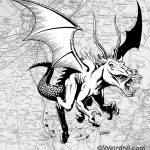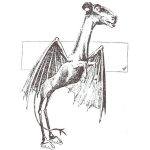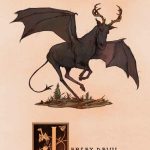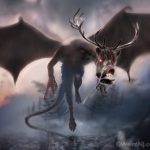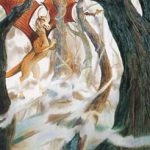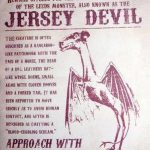The Jersey Devil
In Southern New Jersey and Philadelphia folklore, the Jersey Devil (also known as the Leeds Devil) is a legendary creature said to inhabit the Pine Barrens of South Jersey.
Description
The creature is often described as a flying biped with hooves, but there are many variations. The common description is that of a bipedal kangaroo-like or wyvern-like creature with a horse- or goat-like head, leathery bat-like wings, horns, small arms with clawed hands, legs with cloven hooves, and a forked tail. It has been reported to move quickly and is often described as emitting a high-pitched “blood-curdling scream”.
Origins
While the specific history of the Jersey Devil is debated most people will agree that the first know story originates from the accounts of the Leeds family in the New Jersey Pine Barrens. More detail below.
Sightings
There have been many claims of sightings and occurrences involving the Jersey Devil.
According to legend, while visiting the Hanover Mill Works to inspect his cannonballs being forged, Commodore Stephen Decatur sighted a flying creature and fired a cannonball directly upon it, to no effect.
Joseph Bonaparte, elder brother of Napoleon, is also claimed to have seen the Jersey Devil while hunting on his Bordentown estate about 1820. During 1840, the Jersey Devil was blamed for several livestock killings. Similar attacks were reported during 1841, accompanied by tracks and screams.
In Greenwich during December 1925, a local farmer shot an unidentified animal as it attempted to steal his chickens, and then photographed the corpse. Afterward, he claimed that none of 100 people he showed it to could identify it. On July 27, 1937, an unknown animal “with red eyes” seen by residents of Downingtown, Pennsylvania was compared to the Jersey Devil by a reporter for the Pennsylvania Bulletin of July 28, 1937. In 1951, a group of Gibbstown, New Jersey boys claimed to have seen a ‘monster’ matching the Devil’s description and claims of a corpse matching the Jersey Devil’s description arose in 1957. During 1960, tracks and noises heard near Mays Landing were claimed to be from the Jersey Devil. During the same year the merchants around Camden offered a $10,000 reward for the capture of the Jersey Devil, even offering to build a private zoo to house the creature if it was captured.
Sightings of 1909
During the week of January 16 through 23, 1909, newspapers of the time published hundreds of claimed encounters with the Jersey Devil from all over the state. Among alleged encounters publicized that week were claims the creature “attacked” a trolley car in Haddon Heights and a social club in Camden. Police in Camden and Bristol, Pennsylvania supposedly fired on the creature to no effect. Other reports initially concerned unidentified footprints in the snow, but soon sightings of creatures resembling the Jersey Devil were being reported throughout South Jersey and as far away as Delaware and western Maryland. The widespread newspaper coverage created fear throughout the Delaware Valley prompting a number of schools to close and workers to stay home. Vigilante groups and groups of hunters roamed the pines and countrysides in search of the Devil. During this period, it is rumored that the Philadelphia Zoo posted a $10,000 reward for the creature. The offer prompted a variety of hoaxes, including a kangaroo equipped with artificial claws and bat wings.
aka Leeds Devil

United States
Pine Barrens (New Jersey)
Creature
The Leeds Family (1735)
Deep in the Pine Barrens Mother Leeds referred to as Jane or Deborah Leeds had 12 children and, after finding she was pregnant for the 13th time, cursed the child in frustration, crying that the child would be the devil. During 1735, Mother Leeds was in labor on a stormy night while her friends gathered around her. Born as a normal child, the thirteenth child changed to a creature with hooves, a goat’s head, bat wings, and a forked tail. Growling and screaming, it beat everyone with its tail before flying up the chimney and heading into the pines. In some versions of the tale, Mother Leeds was supposedly a witch and the child’s father was the devil himself. Some versions of the legend also state that there was subsequently an attempt by local clergymen to exorcise the creature from the Pine Barrens.
Prior to the early 1900s, and before the series of reported sightings of the creature during 1909, the Jersey Devil was referred to as the Leeds Devil or the Devil of Leeds, either in connection with the local Leeds family or the eponymous southern New Jersey town, Leeds Point.
“Mother Leeds” has been identified by some as Deborah Leeds, on grounds that Deborah Leeds’ husband, Japhet Leeds, named twelve children in the will he wrote during 1736, which is compatible with the legend. Deborah and Japhet Leeds also lived in the Leeds Point section of what is now Atlantic County, New Jersey, which is commonly the location of the Jersey Devil story.
Brian Regal, a historian of science at Kean University, theorizes that the story of Mother Leeds, rather than being based on a single historical person, originated from colonial southern New Jersey religio-political disputes that became the subject of folklore and gossip among the local population. According to Regal, folk legends concerning these historical disputes evolved through the years and ultimately resulted in the modern popular legend of the Jersey Devil during the early 20th century. Regal contends that “colonial-era political intrigue” involving early New Jersey politicians, Benjamin Franklin, and Franklin’s rival almanac publisher Daniel Leeds (1651–1720) resulted in the Leeds family being described as “monsters”, and it was Daniel Leeds’ negative description as the “Leeds Devil”, rather than any actual creature, that created the later legend of the Jersey Devil.
Much like the Mother Leeds of the Jersey Devil myth, Daniel Leeds’ third wife had given birth to nine children, a large number of children even for the time. Leeds’ second wife and first daughter had both died during childbirth. As a royal surveyor with strong allegiance to the British crown, Leeds had also surveyed and acquired land in the Egg Harbor area, located within the Pine Barrens. The land was inherited by Leeds’ sons and family and is now known as Leeds Point, one of the areas in the Pine Barrens currently most associated with the Jersey Devil legend and alleged Jersey Devil sightings.
Starting in the 17th century, English Quakers established settlements in southern New Jersey, the region in which the Pine Barrens are located. Daniel Leeds, a Quaker and a prominent person of pre-Revolution colonial southern New Jersey, became ostracized by his Quaker congregation after his 1687 publication of almanacs containing astrological symbols and writings. Leeds’ fellow Quakers deemed the astrology in these almanacs as too “pagan” or blasphemous, and the almanacs were censored and destroyed by the local Quaker community.
In response to and in spite of this censorship, Leeds continued to publish even more esoteric astrological Christian writings and became increasingly fascinated with Christian occultism, Christian mysticism, cosmology, demonology and angelology, and natural magic. In the 1690s, after his almanacs and writings were further censored as blasphemous or heretical by the Philadelphia Quaker Meeting, Leeds continued to dispute with the Quaker community, converting to Anglicanism and publishing anti-Quaker tracts criticizing Quaker theology and accusing Quakers of being anti-monarchists. In the ensuing dispute between Leeds and the southern New Jersey Quakers over Leeds’ accusations, Leeds was endorsed by the much-maligned British royal governor of New Jersey, Lord Cornbury, despised among the Quaker communities. Leeds also worked as a councilor to Lord Cornbury about this time. Considering Leeds as a traitor for aiding the Crown and rejecting Quaker beliefs, the Quaker Burlington Meeting of southern New Jersey subsequently dismissed Leeds as “evil”.
During 1716, Daniel Leeds’ son, Titan Leeds, inherited his father’s almanac business, which continued to use astrological content and eventually competed with Benjamin Franklin’s popular Poor Richard’s Almanac. The competition between the two men intensified when, during 1733, Franklin satirically used astrology in his almanac to predict Titan Leeds’ death on October of that same year. Though Franklin’s prediction was intended as a joke at his competitor’s expense and a means to boost almanac sales, Titan Leeds was apparently offended at the death prediction, publishing a public admonition of Franklin as a “fool” and a “liar”. In a published response, Franklin mocked Titan Leeds’ outrage and humorously suggested that, in fact, Titan Leeds had died in accordance with the earlier prediction and was thus writing his almanacs as a ghost, resurrected from the grave to haunt and torment Franklin. Franklin continued to jokingly refer to Titan Leeds as a “ghost” even after Titan Leeds’ actual death during 1738. Daniel Leeds’ blasphemous and occultist reputation and his pro-monarchy stance in the largely anti-monarchist colonial south of New Jersey, combined with Benjamin Franklin’s later ongoing depiction of Titan Leeds as a ghost, may have originated or contributed to the local folk legend of a so-called “Leeds Devil” lurking in the Pine Barrens.
During 1728, Titan Leeds began to include the Leeds family crest on the masthead of his almanacs. The Leeds family crest depicted a wyvern, a bat-winged dragon-like legendary creature that stands upright on two clawed feet. Regal notes that the wyvern on the Leeds family crest is reminiscent of the popular descriptions of the Jersey Devil. The inclusion of this family crest on Leeds’ almanacs may have further contributed to the Leeds family’s poor reputation among locals and possibly influenced the popular descriptions of the Leeds Devil or Jersey Devil. The fearsome appearance of the crest’s wyvern and the increasing animosity among local South Jersey residents towards royalty, aristocracy, and nobility (with whom family crests were associated) may have helped facilitate the legend of the Leeds Devil and the association of the Leeds family with “devils” and “monsters”.
In Popular Cuture
- The 1993 episode of The X-Files titled “The Jersey Devil” features discussion of the legend of the Jersey Devil, as well as an interpretation of the Jersey Devil as being a carnivorous, “wild” humanoid.
- Two professional ice hockey teams have been named for the creature. The first, the Jersey Devils of the Eastern Hockey League, played from 1964 until the league folded in 1973. The second, the New Jersey Devils of the National Hockey League, have played since 1982. The current team was formerly known as the Colorado Rockies, and their name was chosen by a poll shortly after the team relocated to New Jersey.
- The Jersey Devil has appeared in video games, including a game for the original PlayStation named Jersey Devil.
- The Jersey Devil appears in the video game The Wolf Among Us as an agent of the Crooked Man.
- The Jersey Devil appears in the 2007 TMNT, where Raphael (dressed as the Nightwatcher) battles it in a diner kitchen.
- The 2002 horror film 13th Child revolves around the Jersey Devil legend.
- The Spectre of the Pine Barrens is the 17th episode of the first season of the American animated action-adventure television series The Real Adventures of Jonny Quest. It involves the main characters investigating the legend of the Jersey Devil after reports of sightings.
- The Barrens is a 2012 film about the Jersey Devil.
- In Legend Quest, the Jersey Devil appears in “The Jersey Devil” terrorizing the Pine Barrens in the 1800s. It is eventually destroyed by Leo with an iron cannonball. Multiple Jersey Devils appear in “The Serpent and the Egg” as part of Quetzocoatl’s army, all of which are destroyed.
- In 1972, the New Jersey Network televised the story of the Jersey Devil in Mother Leeds’ 13th Child.
- In 2018, the Jersey Devil was included as one of several vinyl figures in Cryptozoic Entertainment’s Cryptkins blind box toy line.
- The Jersey Devil is featured in Season 1, Episode 9 of Aaron Mahnke’s podcast, Lore.
- Bruce Springsteen released a song and video for “A Night With The Jersey Devil”.
- In 2019, Six Flags Great Adventure announced that Rocky Mountain Construction would build a “Jersey Devil Coaster”.
- The Jersey Devil was a subject of Monsters and Mysteries in America.
References
- https://en.wikipedia.org/wiki/Jersey_Devil
- https://www.atlantic-county.org/history/jersey-devil-pg1.asp
- https://weirdnj.com/stories/jersey-devil/
- https://www.nj.com/entertainment/2016/10/13_places_the_jersey_devil_has_been_spotted_in_the.html
- https://pinelandsalliance.org/learn-about-the-pinelands/pinelands-history-and-culture/the-jersey-devil-and-folklore/
- https://www.businessinsider.com/is-this-the-jersey-devil-2013-6
